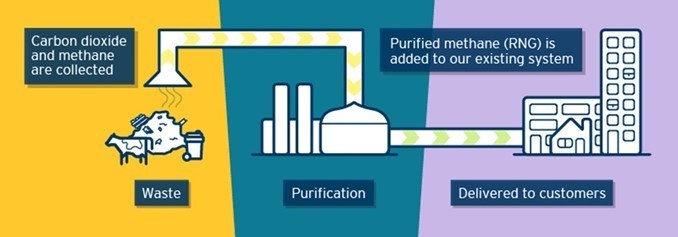
BC study shows province holds wealth of RNG potential
May 3, 2022
By FortisBC Energy
New study shows that B.C.'s renewable and low carbon gas supply could be double current gas use by 2050.
 British Columbia shown to hold a wealth of renewable and low carbon gas potential (CNW Group/FortisBC Energy Inc.)
British Columbia shown to hold a wealth of renewable and low carbon gas potential (CNW Group/FortisBC Energy Inc.) By 2050, the province’s gas system could be completely supplied by made-in-B.C. renewable and low carbon sources.
A study released in March showed that, by 2050, the potential of renewable and low carbon gases could be as high as 440 petajoules (PJ) per year – roughly double what currently flows through FortisBC’s gas infrastructure to British Columbians.
The joint study commissioned by the Government of British Columbia, FortisBC Energy Inc.(FortisBC’s) and BC Bioenergy Network (BCBN) examined the potential production of renewable and low carbon gases using solely B.C. resources by 2030 and 2050, as well as examining overall potential production in Canada and the United States. If the renewable and low carbon gas industry continues to grow, in both capacity and technological innovation, the province has the potential to produce up to 50 PJ of renewable and low carbon gases annually by 2030 and up to 440 PJ by 2050.
The study highlights the importance of renewable and low carbon gases to the province’s energy future and meeting the greenhouse gas emission reduction targets of the CleanBC Roadmap. Replacing conventional natural gas with renewable and low carbon gases can help homes and businesses across the province to decarbonize efficiently and affordably. The existing gas system plays an integral role in meeting the province’s energy needs by delivering reliable, affordable energy to heat B.C. homes and businesses, power industry and to meet heavy demands brought on by cold weather peaks. Using the more than 50,000 kilometres of transmission and distribution lines in FortisBC’s gas system to move growing amounts of renewable and low carbon gases instead of conventional natural gas can significantly reduce greenhouse gas (GHG) emissions in the building, industrial and transportation sectors.
“As the first utility in North America to provide Renewable Natural Gas to our customers over a decade ago, we’ve been on a journey to transform B.C.’s renewable and low carbon gas sector. Understanding the enormous potential the province has to produce renewable and low carbon gases shows a clear path forward to scale up the decarbonization of our gas system,” said Joe Mazza, vice-president, gas supply and resource development at FortisBC. “As a utility that also delivers clean hydroelectricity, we’re excited to advance a decarbonized gas system working alongside the electric system to maintain a provincial energy system that meets all of the needs of British Columbians efficiently and affordably.”
In 2018, both the Government of British Columbia and FortisBC set a target of 15 per cent of the gas supply being renewable or low carbon by 2030. With the desire for faster and deeper decarbonization, it’s expected that target may grow and the most recent projections from FortisBC show that the company should exceed that number, as the momentum of bringing on new sources of RNG is steadily growing. The company tripled its supply of RNG through 2021 and expects to, at minimum, triple its supply again in 2022. FortisBC’s vision for renewable and low carbon gas is to have roughly 75 per cent of its total gas supply be renewable or low carbon by 2050 to meet the province’s 80 per cent GHG reduction target.
“As a growing producer in the province’s renewable and low carbon gas sector, this study confirms our belief in B.C.’s ability to become a North American leader in RNG and other low carbon gases. EverGen will continue to grow its production of RNG in B.C. and across Canada to help provide homes, business and industry with an effective and affordable way to decarbonize,” said Chase Edgelow, CEO of EverGen, a leading Canadian renewable energy company.
Renewable natural gas sourced from biogas is only one of the renewable and low carbon gases expected to play a role in the province’s energy future. Hydrogen also offers immense opportunity for a lower-carbon B.C. Using B.C.’s renewable electricity and its natural gas reserves with carbon capture technologies could open new opportunities to reduce emissions in B.C. and abroad. The study also noted low carbon gas production from wood waste has significant potential for future supply through more research and development to unlock the resource on a large scale.
The study notes an expected growth of renewable and low carbon gases as a whole across North America moving forward. National and international competition for this growing supply is also expected to increase so, while purchasing RNG from the larger market may help meet shorter term supply targets, it is important for the province to develop its domestic capacity—building resilient communities and positioning B.C. as a world leader in advancing a low-carbon economy.
“This was a remarkable collaboration involving the BC Government, FortisBC, BCBN and ENVINT Consulting,” said Dr. Scott Stanners, Executive Director at BCBN. “We are pleased by the dedication of our expert working group to advance the low-carbon economy in B.C. It is partnerships such as these that bring us closer to the target in the CleanBC Roadmap to 2030 and result in a greener future.”
Renewable and low carbon gases are a key element in reaching the GHG emission reduction goals of the Province’s CleanBC Roadmap, which aims to reduce GHG emissions in the buildings and industry sectors by 47 per cent overall. With a heightened expectation on gas utilities to reduce carbon emissions, decarbonizing the gas system by increasing renewable and low carbon gas supply will help B.C. have a more resilient energy system. Following a path that utilizes both gas and electric systems, can reach the same level of GHG emissions reductions as an electrification strategy and meet the province’s emissions reduction targets.
Print this page